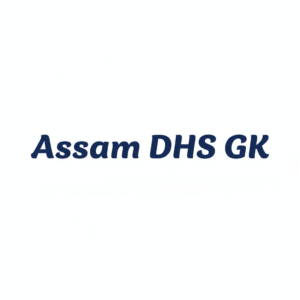50 Advanced MCQ on Assam Geography Gk
Are you ready to master Assam Geography GK at the highest level? This collection presents 50 tough and unique multiple choice questions covering Assam’s physical features, districts, rivers, minerals, natural zones, and advanced concepts rarely found in ordinary quizzes. Perfect for competitive exam aspirants, teachers, and serious learners, these challenging Assam Geography GK questions are designed to test your deep understanding and expand your general knowledge. Attempt each question carefully and see how well you know the complexities of Assam’s landscape and geo-facts
Why Should You Stay and Attempt This Assam Geography GK MCQ Quiz?
-
Deepen Your Understanding: You’ll encounter advanced and rarely asked concepts, helping you master topics beyond the basics.
-
Build Exam Confidence: Practicing tough questions boosts your confidence for competitive exams like APSC, SSC, and other Assam state tests.
-
Identify Knowledge Gaps: Immediate participation helps you discover your strengths and areas needing improvement, making your future study sessions more focused and efficient.
-
Stay Updated: These questions are designed to reflect recent trends and deep facts about Assam’s geography, ensuring you stay ahead in your subject knowledge.
-
Experience Real Exam Challenge: The quiz mimics real exam difficulty, training you to handle tricky and high-level questions under pressure.
Stay, attempt every question, and turn this quiz into your secret weapon for exam success and all-round Assam Geography GK mastery
1. The ‘Cachar Fold Belt' in Assam is geologically considered part of which larger tectonic zone?
a) Indo-Burmese Orogenic Belt
b) Shillong Plateau
c) Eastern Himalayan Syntaxis
d) Bengal Basin
Answer: a) Indo-Burmese Orogenic Belt
2. As per seismic microzonation, which city in Assam falls in the highest damage potential zone (Zone V) for earthquakes?
a) Silchar
b) Jorhat
c) Guwahati
d) Golaghat
Answer: c) Guwahati
3. The Dihing Patkai National Park is predominantly located in which two districts?
a) Dibrugarh & Tinsukia
b) Golaghat & Karbi Anglong
c) Sivasagar & Dibrugarh
d) Dima Hasao & Cachar
Answer: a) Dibrugarh & Tinsukia
4. Which locally named wind in Assam is notorious for intensifying pre-monsoon thunderstorms?
a) Bordoichila
b) Nor’wester
c) Kalbaishakhi
d) Loo
Answer: a) Bordoichila
5. Which is the deepest point of the Brahmaputra river within Assam’s territory?
a) Near Sadiya
b) Near Tezpur
c) Near Dhubri
d) Near Dibrugarh
Answer: c) Near Dhubri
6. Which river in Assam is famous for supporting the highest density of riverine island agriculture (crop on sandbars)?
a) Brahmaputra
b) Kopili
c) Dhansiri
d) Subansiri
Answer: a) Brahmaputra
7. The ‘Sutargaon Gap’ in Assam refers to:
a) A corridor between Karbi Anglong and North Cachar Hills
b) A water divide between Subansiri and Brahmaputra
c) A tectonic gap in the Patkai range
d) The break between Kaziranga and Nameri National Parks
Answer: a) A corridor between Karbi Anglong and North Cachar Hills
8. Which town in Assam is noted for earth resources research due to the presence of a Geomagnetic Observatory?
a) Diphu
b) Dibrugarh
c) Silchar
d) Gauhati (Guwahati)
Answer: d) Gauhati (Guwahati)
9. Which physiographic unit in Assam is particularly vulnerable to landslides due to intense lateral river erosion?
a) North Cachar Hills
b) Barail Range
c) Bhabar Zone
d) Karbi Anglong Plateau
Answer: a) Bhabar Zone
10. The ‘Bodo belt' refers to which specific tract in Assam?
a) North bank Brahmaputra plain west of Manas
b) All of Barak Valley
c) South bank between Kaziranga and Tezpur
d) The plateau fringes of Upper Assam
Answer: a) North bank Brahmaputra plain west of Manas
11. The ‘Chapari’ lands of Assam are best described as:
a) Elevated fluvial terraces
b) Periodically submerged floodplains
c) Marshy oxbow lakes
d) Heavily forested hillocks
Answer: a) Elevated fluvial terraces
12. Between which two districts does the Brahmaputra River split into two distributaries creating “Phulbari Island” during high floods?
a) Dibrugarh & Dhemaji
b) Golaghat & Morigaon
c) Goalpara & Dhubri
d) Barpeta & Kamrup
Answer: c) Goalpara & Dhubri
13. The natural grassland eco-type of Kaziranga is termed:
a) Terai grassland
b) Phumdis
c) Prairie
d) Tall wet savanna
Answer: d) Tall wet savanna
14. Which rare mineral found in Karbi Anglong is considered strategic for advanced ceramic and aerospace industries?
a) Sillimanite
b) Zircon
c) Graphite
d) Monazite
Answer: a) Sillimanite
15. The town of Sadiya is geologically significant because it sits at the confluence of which three major rivers?
a) Dibang, Lohit, Brahmaputra
b) Subansiri, Kopili, Dhansiri
c) Barak, Jiri, Katakhal
d) Manas, Beki, Pagladiya
Answer: a) Dibang, Lohit, Brahmaputra
16. At which location is the only petrified forest (fossil wood) site of Assam found?
a) Golaghat
b) Margherita
c) Umrangso
d) Dhubri
Answer: c) Umrangso
17. Which district hosts the largest freshwater swamp-forest in Assam?
a) Sivasagar
b) Dhemaji
c) Jorhat
d) Tinsukia
Answer: d) Tinsukia (Dibru-Saikhowa area, Maguri Motapung Beel)
18. The locally important “Khumtai” reserve in Assam is known for:
a) Tea germplasm
b) Sal forests
c) Wild elephants
d) Fossil wood
Answer: a) Tea germplasm
19. Which river forms the boundary between the hill districts of Dima Hasao and Karbi Anglong?
a) Kapili
b) Jamuna
c) Dhansiri
d) Jatinga
Answer: a) Kapili
20. The ‘Nambor Doigrung’ area is famous for which of the following?
a) Turtle Sanctuary
b) Medicinal hot springs
c) Important Bird and Biodiversity Area (IBA)
d) Fossilized teak forest
Answer: c) Important Bird and Biodiversity Area (IBA)
21. “Sonai Rupai” refers to:
a) A wildlife sanctuary in Sonitpur
b) Major floodplain of Barak valley
c) Plateau valley famous for rice cultivation
d) Riverine tract in Sivsagar
Answer: a) A wildlife sanctuary in Sonitpur
22. In which Assam district is the extreme easternmost point of the state located?
a) Tinsukia
b) Sivasagar
c) Dhemaji
d) Dibrugarh
Answer: a) Tinsukia
23. The maximum width of the Brahmaputra basin in Assam is recorded at:
a) Dibrugarh
b) Sadiya
c) Koliabor
d) Dhubri
Answer: d) Dhubri
24. Which protected area in Assam forms part of the Eastern Himalayan Endemic Bird Area?
a) Nameri National Park
b) Kaziranga National Park
c) Manas National Park
d) Dihing Patkai National Park
Answer: a) Nameri National Park
25. The river ‘Ranganadi' is dammed at which location in Assam for hydroelectric power?
a) Lakhimpur
b) Dibrugarh
c) Dhemaji
d) Jorhat
Answer: a) Lakhimpur
26. Which unique Assamese wetland is known for its floating islands of vegetation (phumdis)?
a) Deepor Beel
b) Son Beel
c) Tongan Beel
d) Maguri Beel
Answer: b) Son Beel (though phumdis are best known from Manipur, similar ‘floating’ mats exist seasonally in Son Beel)
27. The Tinsukia district is globally important for which critically endangered bird?
a) White-winged duck
b) Bengal Florican
c) Greater adjutant stork
d) Swamp francolin
Answer: a) White-winged duck (found in Dibru-Saikhowa)
28. Bherjan–Borajan–Padumoni is a single wildlife sanctuary notable for:
a) Connected tracts of riverine tiger habitat
b) Three fragmented patches of protected forest
c) Single largest elephant corridor
d) The largest heronry in Assam
Answer: b) Three fragmented patches of protected forest
29. The ‘Doyang' river is the major tributary of which system in Assam?
a) Dhansiri
b) Barak
c) Manas
d) Kapili
Answer: a) Dhansiri
30. Which district lies immediately to the north of the Barail Range?
a) Cachar
b) Dima Hasao
c) Hailakandi
d) Karimganj
Answer: b) Dima Hasao
31. The Sivasagar district is geologically notable because it sits on:
a) A petroleum-rich anticline
b) An ancient fossil reef
c) The Great Boundary Fault
d) A copper-thorium uranium zone
Answer: a) A petroleum-rich anticline
32. The highest rainfall in Assam is not received in Cherapunjee or Mawsynram but in which Assam locality?
a) Haflong
b) North Lakhimpur
c) Borbhag (Kamalpur)
d) Golaghat
Answer: a) Haflong (within Assam’s borders; Meghalaya’s Cherapunjee/Mawsynram have highest nationally The highest recorded single-day rainfall within Assam occurred in Haflong, Dima Hasao district. On 14 May 2022, Haflong received 451 mm of rain in just 24 hours—remarkably high compared to its typical annual maximum of around 190–200 mm)
33. The major source of water for paddy irrigation in lower Assam is:
a) Traditional tank system
b) Lift irrigation from Brahmaputra
c) Rain-fed canals (beel irrigation)
d) Tube-well networks
Answer: c) Rain-fed canals (beel irrigation)
34. Which mineral is extensively extracted alongside coal in the Makum coalfields?
a) Silica sand
b) Pyrite
c) Sulphur
d) China clay
Answer: China clay
35. The ‘Katakhal' river valley is famed for:
a) High-yield jute
b) Wet rice and bamboo settlements
c) Karimganj’s pineapple plantations
d) Oil palm agro-ecozone
Answer: b) Wet rice and bamboo settlements
36. Which river's extensive floodplain supports the migratory cattle herding (Charwa) system?
a) Brahmaputra
b) Manas
c) Kapili
d) Kundil
Answer: a) Brahmaputra
37. The alluvial fan deposit at the foot of the Naga hills is primarily composed of:
a) Micaceous sandy loam
b) Calcareous gravels
c) Peat-rich clay
d) Red laterite
Answer: a) Micaceous sandy loam
38. Which protected area in Assam features the highest recorded diversity of wild orchids?
a) Nambor Wildlife Sanctuary
b) Dehing Patkai National Park
c) Garampani Wildlife Sanctuary
d) Hollongapar Gibbon Sanctuary
Answer: b) Dehing Patkai National Park
39. Which Assamese region is known for the “bogori” (Indian jujube) commercial orchards on floodplain levees?
a) Lakhimpur
b) Barpeta
c) Goalpara
d) Morigaon
Answer: b) Barpeta
40. The Dima Hasao district contains unique tableland called:
a) Jatinga Plateau
b) Jampui Range
c) Lumding Hill
d) Haflong Tableland
Answer: d) Haflong Tableland
41. Assam’s largest and most productive ‘beel’ (oxbow-type wetland) is home to:
a) Commercial eel fishery
b) Endangered golden mahseer
c) Wild water buffalo herds
d) Assam roofed turtle
Answer: a) Commercial eel fishery
42. The historic Charaideo Maidam of Assam is essentially:
a) An earthen burial mound (Ahom royal tomb)
b) An ancient copper mining colony
c) Prehistoric cave dwelling
d) Traditional silk weaving hamlet
Answer: a) An earthen burial mound (Ahom royal tomb)
43. The dominant forest type of the Barail range is:
a) Moist sub-tropical evergreen
b) Mangrove forest
c) Xeric thorn scrub
d) Bamboo bract forest
Answer: a) Moist sub-tropical evergreen
44. Which Assam hill region is known for recurring orographic rainfall-induced landslides, especially affecting railways?
a) Barail Range
b) Mikir Hills
c) Dafla Hills
d) Rengma Hills
Answer: a) Barail Range
45. The “Bodo Hills” (also called “Duars”) refer to:
a) Himalayan foothills crossing into Bhutan–Assam tract
b) Plateaus near Sadiya
c) Passes along the Meghalaya border
d) Ravines at the southern bank of Barak valley
Answer: a) Himalayan foothills crossing into Bhutan–Assam tract
46. Which river originates from Jampui hills and flows southwest across southern Assam?
a) Longai
b) Jiri
c) Barak
d) Kopili
Answer: a) Longai
47. The Patkai range is primarily formed of rocks from which geological period?
a) Tertiary
b) Cambrian
c) Mesozoic
d) Carboniferous
Answer: a) Tertiary
48. The unique “Haduk” system found in the goalpara region refers to:
a) Group fishing with funnel-shaped nets
b) Slash and burn shifting cultivation
c) Collective weaving loom for silk
d) Riverbank paddy transplantation
Answer: a) Group fishing with funnel-shaped nets
49. Which Assam district is crossed by India’s longitudinal Standard Meridian of 82°30’E?
a) Goalpara
b) Nagaon
c) Kamrup Rural
d) Biswanath
Answer: a) Goalpara
50. In the context of Assam, “Mar” land (or “Maar-dang”) is specifically:
a) Heavy clay soil in the floodplain ideal for winter crops
b) Sandy, erosion-prone chars
c) Lahar deposit from hill slopes
d) Elevated peatland supporting tea
Answer: a) Heavy clay soil in the floodplain ideal for winter crops
Thank you for attempting this challenging Assam Geography GK MCQ quiz. Regular practice with high-level questions like these sharpens your knowledge and boosts your confidence for competitive exams. Don’t forget to try our other Assam GK quizzes for all-round preparation. Keep practicing and good luck with your exam journey.
Explore More Assam Geography GK Resources
Looking for more in-depth coverage and practice on Assam Geography GK? Check out our related quizzes, study guides, and expert articles below. Each link features unique questions, updated facts, and exam-focused content to help you master Assam geography for competitive exams. Click the links to continue your learning and maximize your exam success
100 Important Assam Geography MCQs
Important 50+ MCQ On Geography of Assam (2025)
Tropic of Cancer | 50 Important MCQs with Answers
50 Important MCQs on Assam Forests and Wildlife | Part One
50 Important MCQs on Assam Forests and Wildlife | Part two
The Poona Pact 1932 | Historical Significance, Key Provisions, and Impact on Dalit Rights
The Early History of Assam – Exploring the Roots of an Ancient Land





